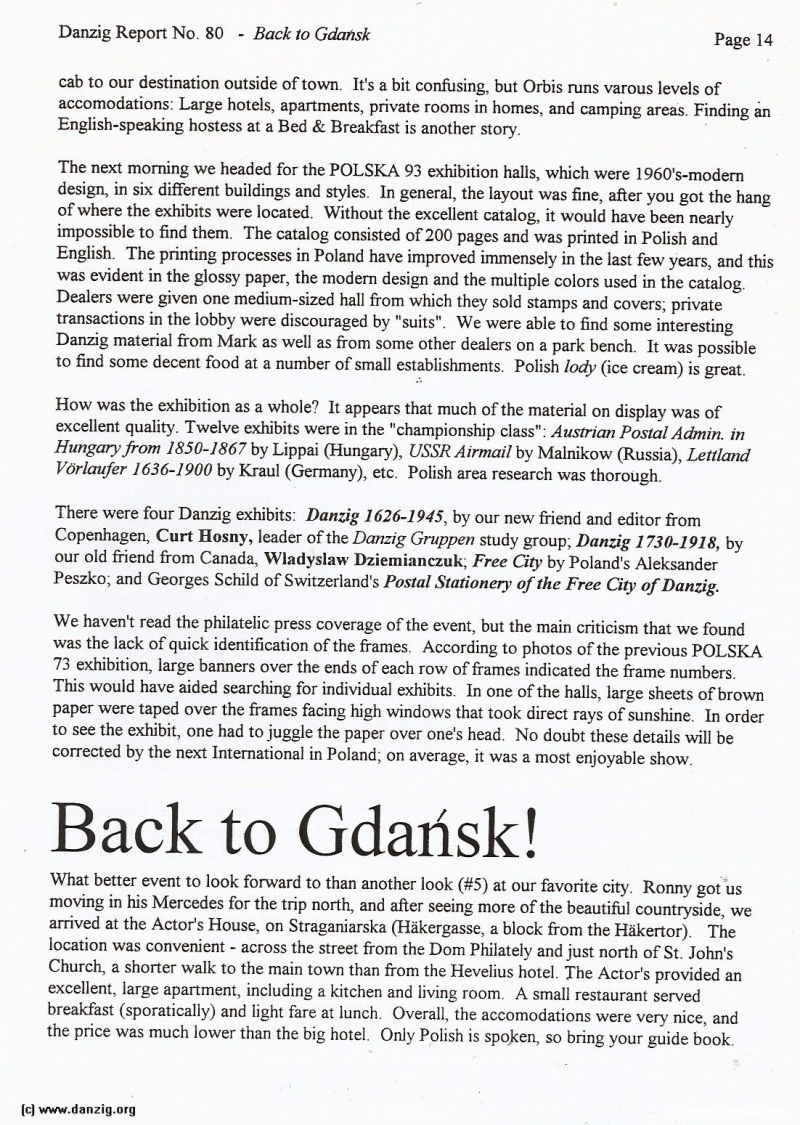
cab to our destination outside of town. It’s a bit confusing, but Orbis runs varous levels of accomodations: Large hotels, apartments, private rooms in homes, and camping areas. Finding an English-speaking hostess at a Bed & Breakfast is another story.
The next morning we headed for the POLSKA 93 exhibition halls, which were 1960’s-modern design, in six different buildings and styles. In general, the layout was fine, after you got the hang of where the exhibits were located. Without the excellent catalog, it would have been nearly impossible to find them. The catalog consisted of 200 pages and was printed in Polish and English. The printing processes in Poland have improved immensely in the last few years, and this was evident in the glossy paper, the modern design and the multiple colors used in the catalog. Dealers were given one medium-sized hail from which they sold stamps and covers; private transactions in the lobby were discouraged by “suits”. We were able to find some interesting Danzig material from Mark as well as from some other dealers on a park bench. It was possible to find some decent food at a number of small establishments. Polish lody (ice cream) is great.
How was the exhibition as a whole? It appears that much of the material on display was of
excellent quality. Twelve exhibits were in the “championship class”: Austrian PostalAdmin. in Hungaiy from 1850-1867 by Lippai (Hungary), USSR Airmail by Malnikow (Russia), Let/land Vorlaufer 1636-1900 by Kraul (Germany), etc. Polish area research was thorough.
There were four Danzig exhibits: Danzig 1626-1945, by our new friend and editor from
Copenhagen, Curt Hosny, leader of the Danzig Gruppen study group; Danzig 1730-1918, by
our old friend from Canada, Wladyslaw Dziemianczuk; Free City by Poland’s Aleksander
Peszko; and Georges Schild of Switzerland’s Postal Stationerp of the Free City of Danzig.
We haven’t read the philatelic press coverage of the event, but the main criticism that we found was the lack of quick identification of the frames. According to photos of the previous POLSKA 73 exhibition, large banners over the ends of each row of frames indicated the frame numbers. This would have aided searching for individual exhibits. In one of the halls, large sheets of brown paper were taped over the frames facing high windows that took direct rays of sunshine. In order to see the exhibit, one had to juggle the paper over one’s head. No doubt these details will be corrected by the next International in Poland; on average, it was a most enjoyable show.
Back to Gdañsk!
What better event to look forward to than another look (#5) at our favorite city. Ronny got us moving in his Mercedes for the trip north, and after seeing more of the beautiful countryside, we arrived at the Actor’s House, on Straganiarska (Hakergasse, a block from the Häkertor). The location was convenient - across the Street from the Dom Philately and just north of St. John’s Church, a shorter walk to the main town than from the Hevelius hotel. The Actor’s provided an excellent, large apartment, including a kitchen and living room. A small restaurant served breakfast (sporatically) and light fare at lunch. Overall, the accomodations were very nice, and the price was much lower than the big hotel. Only Polish is spojcen, so bring your guide book.
Danzig Report Vol. 1 - Nr. 80 - July - August - September - 1993, Page 16.
Hits: 4024
Added: 05/07/2015
Copyright: 2025 Danzig.org

